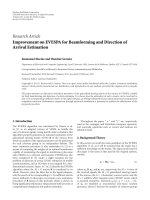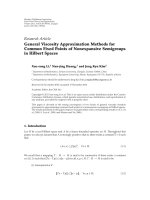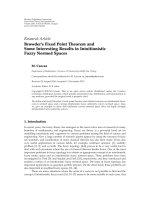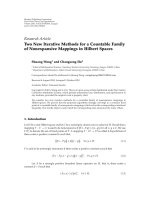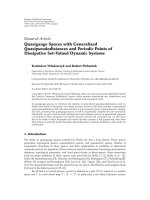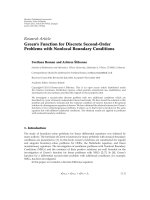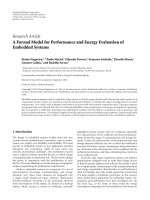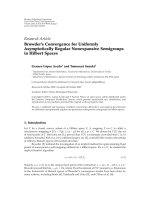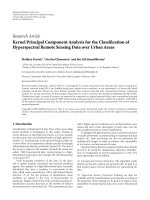Báo cáo hóa học: " Research Article Hilbert’s Type Linear Operator and Some Extensions of Hilbert’s Inequality" doc
Bạn đang xem bản rút gọn của tài liệu. Xem và tải ngay bản đầy đủ của tài liệu tại đây (488.16 KB, 10 trang )
Hindawi Publishing Corporation
Journal of Inequalities and Applications
Volume 2007, Article ID 82138, 10 pages
doi:10.1155/2007/82138
Research Article
Hilbert’s Type Linear Operator and Some Extensions of
Hilbert’s Inequality
Yongjin Li, Zhiping Wang, and Bing He
Received 17 April 2007; Accepted 3 October 2007
Recommended by Ram N. Mohapatra
The norm of a Hilbert’s type linear operator T : L
2
(0,∞) →L
2
(0,∞)isgiven.Asappli-
cations, a new generalizations of Hilbert integral inequality, and the result of series ana-
logues are given correspondingly.
Copyright © 2007 Yongjin Li et al. This is an open access article distributed under the
Creative Commons Attribution License, which p ermits unrestricted use, distribution,
and reproduction in any medium, provided the original work is properly cited.
1. Introduction
At the close of the 19th century a theorem of great elegance and simplicity was discovered
by D. Hilbert.
Theorem 1.1 (Hilbert’s double series theorem). The series
∞
m=1
∞
n=1
a
m
a
n
m +n
(1.1)
is convergent whenever
∞
n=1
a
2
n
is convergent.
The Hilbert’s inequalities were studied extensively; refinements, generalizations, and
numerous variants appeared in the literature (see [1, 2]). Firstly, we will recall some
Hilbert’s inequalities. If f (x),g(x)
≥ 0, 0 <
∞
0
f
2
(x) dx < ∞and 0 <
∞
0
g
2
(x) dx < ∞,then
∞
0
∞
0
f (x)g(y)
x + y
dx dy < π
∞
0
f
2
(x) dx
1/2
∞
0
g
2
(x) dx
1/2
, (1.2)
where the constant factor π is the best possible. Inequality (1.2)isnamedofHardy-
Hilbert’s integral inequality (see [3]). Under the same condition of (1.2), we have the
2 Journal of Inequalities and Applications
Hardy-Hilbert’s type inequality (see [3], Theorem 319, Theorem 341) similar to (1.2):
∞
0
∞
0
f (x)g(y)
max{x, y}
dx dy < 4
∞
0
f
2
(x) dx
1/2
∞
0
g
2
(x) dx
1/2
, (1.3)
where the constant factor 4 is also the best possible. The corresponding inequalities for
series are:
∞
n=1
∞
m=1
a
m
b
n
m +n
<π
∞
n=1
a
2
n
1/2
∞
n=1
b
2
n
1/2
;
∞
n=1
∞
m=1
a
m
b
n
max{m,n}
< 4
∞
n=1
a
2
n
1/2
∞
n=1
b
2
n
1/2
,
(1.4)
where the constant factors π and 4 are both the best possible.
Let H be a real separable Hilbert space, and T : H
→H be a bounded self-adjoint semi-
positive definite operator, then (see [4])
(x, Ty)
2
≤
T
2
2
x
2
y
2
+(x, y)
2
, (1.5)
where x, y
∈ H and x=
(x, x)isthenormofx.
Set H
= L
2
(0,∞) ={f (x):
∞
0
f
2
(x) dx < ∞} and define T : L
2
(0,∞)→L
2
(0,∞)asthe
following:
(Tf)(y):
=
∞
0
1
x + y
f (x)dx, (1.6)
where y
∈ (0,∞). It is easy to see T is a bounded operator (see [5]). By (1.5), one has the
sharper form of Hilbert’s inequality as (see [4]),
∞
0
∞
0
f (x)g(y)
x + y
dx dy
≤
π
√
2
∞
0
f
2
(x) dx
∞
0
g
2
(x) dx +
∞
0
f (x)g(x)dx
2
1/2
.
(1.7)
Recently, Yang [6, 7] studied the Hilbert’s inequalities by the norm of some Hilbert’s
ty pe linear operators.
ThemainpurposeofthisarticleistostudythenormofaHilbert’stypelinearoperator
with the kernel Amin
{x, y}+ B max{x, y} andgivesomenewgeneralizationsofHilbert’s
inequality. As applications, we also consider some particular results.
Yongjin Li et al. 3
2. Main results and applications
Lemma 2.1. Define the weight function (x) as
(x):
=
∞
0
1
Amin{x, y}+ B max{x, y}
x
y
1/2
dy, x ∈ (0,∞),
(y)
∞
0
1
Amin{x, y}+ B max{x, y}
y
x
1/2
dx, y ∈ (0,∞).
(2.1)
Then (x)
= (y) = D(A,B) is a constant and 0 <D(A,B) < ∞.
In particular, one has D(1,1)
= π and D(1,0) = 4.
Proof. For fixed x, letting t
= y/x,weget
(x)
=
∞
0
1
A min{x, y}+ B max {x, y}
x
y
1/2
dy
=
∞
0
1
A min{1,t}+B max{1,t}
t
−1/2
dt
=
1
0
1
At + B
t
−1/2
dt +
∞
1
1
A +Bt
t
−1/2
dt
=
1
√
AB
A/B
0
1
1+t
t
−1/2
dt +
1
√
AB
∞
B/A
1
1+t
t
−1/2
dt
≤
1
√
AB
∞
0
1
1+t
t
−1/2
dt +
1
√
AB
∞
0
1
1+t
t
−1/2
dt
=
2
√
AB
B
1
2
,
1
2
< ∞.
(2.2)
therefore 0 <D(A,B) <
∞.Moreover,
(y)
=
∞
0
1
Amin{x, y}+ B max{x, y}
y
x
1/2
dx
=
∞
0
1
Amin{1,t}+B max {1,t}
t
−1/2
dt
=
1
0
1
At + B
t
−1/2
dt +
∞
1
1
A +Bt
t
−1/2
dt
=
1
√
AB
A
−1+(1/2)
B
1/2
A/B
0
1
1+t
t
−1/2
dt +
1
√
AB
∞
B/A
1
1+t
t
−1/2
dt
=
1
√
AB
A/B
0
1
1+u
u
−1/2
du+
1
√
AB
∞
B/A
1
1+u
u
−1/2
du
(2.3)
(setting t
= 1/u).
4 Journal of Inequalities and Applications
Thus (y)
= D(A,B). In particular:
D(1, 1)
=
∞
0
1
x + y
y
x
1/2
dx =
∞
0
1
1+t
t
−1/2
dt = π,
D(0, 1)
=
∞
0
1
max{x, y}
y
x
1/2
dx =
∞
0
1
max{1,t}
t
−1/2
dt = 4.
(2.4)
Theorem 2.2. Let A ≥ 0, B>0 and T : L
2
(0,∞)→L
2
(0,∞) is defined as follows:
(Tf)(y):
=
∞
0
1
Amin{x, y}+ B max{x, y}
f (x)dx (y ∈ (0,∞)). (2.5)
Then
T=D(A,B),andforany f (x),g(x) ≥ 0, f ,g ∈ L
2
(0,∞), one has (Tf,g) <
D( A, B)
f g, that is,
∞
0
∞
0
f (x)g(y)
Amin{x, y}+ B max{x, y}
dx dy < D(A,B)
∞
0
f
2
(x) dx
1/2
∞
0
g
2
(x) dx
1/2
,
(2.6)
where the constant factor D(A,B) is the best possible. In particular,
(i) for A
= B = 1, it reduces to Hardy-Hilbert’s inequality:
∞
0
∞
0
f (x)g(y)
x + y
dx dy < π
∞
0
f
2
(x) dx
1/2
∞
0
g
2
(x) dx
1/2
; (2.7a)
(ii) for A
= 0, B =1, it reduces to Hardy-Hilbert’s type inequality:
∞
0
∞
0
f (x)g(y)
max{x, y}
dx dy < 4
∞
0
f
2
(x) dx
1/2
∞
0
g
2
(x) dx
1/2
. (2.7b)
Proof. For A>0, B>0. Applying H
¨
older’s inequality, we obtain
(Tf,g)
=
∞
0
f (x)
A min{x, y}+ B max {x, y}
dx,g(y)
=
∞
0
∞
0
f (x)
A min{x, y}+ B max {x, y}
dx
g(y)dy
Yongjin Li et al. 5
=
∞
0
∞
0
f (x)g(y)
A min{x, y}+ B max {x, y}
dx dy
=
∞
0
∞
0
1
A min{x, y}+ B max{x, y}
f (x)
x
y
1/4
g(y)
y
x
1/4
dx dy
≤
∞
0
∞
0
f
2
(x)
A min{x, y}+ B max {x, y}
x
y
1/2
dxdy
1/2
×
∞
0
∞
0
g
2
(y)
A min{x, y}+ B max {x, y}
y
x
1/2
dx dy
1/2
=
∞
0
(x) f
2
(x) dx
1/2
∞
0
(y)g
2
(y)dy
1/2
= D(A,B)
∞
0
f
2
(x) dx
1/2
∞
0
g
2
(y)dy
1/2
= D(A,B)f g.
(2.8)
Thus
T≤D(A,B) and the inequality (2.6)holds.
Assume that (2.8) takes the form of the equality, then there exist constants a and b,
such that they are not both zero and (see [8])
af
2
(x)
x
y
1/2
= bg
2
(y)
y
x
1/2
. (2.9)
Then, we have
af
2
(x) x =bg
2
(y)y a.e. on (0,∞) × (0,∞). (2.10)
Hence there exist a constant d,suchthat
af
2
(x) x =bg
2
(y)y = d a.e. on (0,∞) × (0,∞). (2.11)
Without losing the generality, suppose a
=0, then we obtain f
2
(x) = d/(ax), a.e. on
(0,
∞), which contradicts the fact that 0 <
∞
0
f
2
(x) dx < ∞.Hence(2.8) takes the form
of strict inequality, we obtain (2.6).
For ε>0sufficiently small, set f
ε
(x) = x
(−1−ε)/2
,forx ∈ [1,∞); f
ε
(x) = 0, for x ∈ (0,1).
Then g
ε
(y) = y
(−1−ε)/2
,fory ∈ [1,∞); g
ε
(y) = 0, for y ∈ (0,1). Assume that the constant
factor D(A,B)in(2.6) is not the best possible, then there exist a positive real number K
6 Journal of Inequalities and Applications
with K<D(A,B), such that (2.6) is valid by changing D(A,B)toK. On one hand,
∞
0
∞
0
f (x)g(y)
Amin{x, y}+ B max{x, y}
dx dy < K
∞
0
f
2
ε
(x) dx
1/2
∞
0
g
2
ε
(x) dx
1/2
= K/ε.
(2.12)
On the other hand, setting t
= y/x,wehave
∞
0
∞
0
f
ε
(x) g
ε
(y)
Amin{x, y}+ B max{x, y}
dx dy
=
∞
1
∞
1
x
(−1−ε)/2
y
(−1−ε)/2
Amin{x, y}+ B max{x, y}
dx dy
=
∞
1
x
−1−ε
∞
1/x
t
(−1−ε)/2
Amin{1,t}+B max {1,t}
dt dx
=
∞
1
x
−1−ε
∞
0
t
(−1−ε)/2
Amin{1,t}+B max {1,t}
dt dx
−
∞
1
x
−1−ε
1/x
0
t
(−1−ε)/2
Amin{1,t}+B max {1,t}
dt dx.
(2.13)
For x
≥ 1, we get
1/x
0
t
(−1−ε)/2
Amin{1,t}+B max {1,t}
dt
=
1/x
0
t
(−1−ε)/2
At + B
dt
≤
1
B
1/x
0
t
(−1−ε)/2
dt
=
1
B
1
1 −(1 +ε)/2
1
x
1−(1+ε)/2
≤
4
B
x
−1/4
(2.14)
(setting 0 <ε<1/2).
Thus
0 <
∞
1
x
−1−ε
1/x
0
t
(−1−ε)/2
Amin{1,t}+B max {1,t}
dtdx
≤
4
B
∞
1
x
−1−ε−1/4
dx
≤
4
B
∞
1
x
−1−1/4
dx =
16
B
.
(2.15)
Yongjin Li et al. 7
Note that
∞
1
x
−1−ε
1/x
0
t
(−1−ε)/2
Amin{1,t}+B max {1,t}
dtdx = O(1). (2.16)
So the inequality
∞
0
∞
0
( f
ε
(x) g
ε
(y)/(Amin{x, y}+B max {x, y}))dxdy = (1/ε)[D(A,B)+
o(1)]
−O(1) = (1/ε)[D(A,B)+o(1)]. Thus we get (1/ε)[D(A, B, p)+o(1)] ≤ K/ε, that is,
D( A, B)
≤ K when ε is sufficiently small, which contradicts the hypothesis. Hence the
constant factor D(A,B)in(2.6) is the best possible and
T=D(A,B). This completes
the proof.
Theorem 2.3. Suppose that f ≥ 0, A ≥0, B>0 and 0 <
∞
0
f
2
(x) dx < ∞. Then
∞
0
∞
0
f (x)
Amin{x, y}+ B max{x, y}
dx
2
dy <D
2
(A,B)
∞
0
f
2
(x) dx, (2.17)
where the constant factor D
2
(A,B) is the best possible. Inequality (2.17)isequivalentto(2.6 ).
Proof. Let g(y)
=
∞
0
( f (x)/(Amin{x, y}+B max {x, y}))dx,thenby(2.6), we get
0 <
∞
0
g
2
(y)dy
=
∞
0
∞
0
f (x)
Amin{x, y}+ B max{x, y}
dx
2
dy
=
∞
0
∞
0
f (x)g(y)
Amin{x, y}+ B max{x, y}
dx dy
≤ D(A,B)
∞
0
f
2
(x) dx
1/2
∞
0
g
2
(y)dy
1/2
.
(2.18)
Hence, we obtain
0 <
∞
0
g
2
(y)dy =D
2
(A,B)
∞
0
f
2
(x) dx < ∞. (2.19)
By (2.6), both (2.18)and(2.19) take the form of strict inequality, so we have (2.17). On
the other hand, suppose that (2.17)isvalid.ByH
¨
older’s inequalit y, we find
∞
0
∞
0
f (x)g(y)
Amin{x, y}+ B max{x, y}
dx dy
=
∞
0
∞
0
f (x)
Amin{x, y}+ B max{x, y}
dx
g(y)dy
≤
∞
0
∞
0
f (x)
Amin{x, y}+ B max{x, y}
dx
2
dy
1/2
∞
0
g
2
(x) dx
1/2
.
(2.20)
By (2.17), we have (2.6). Thus (2.6)and(2.17) are equivalent.
8 Journal of Inequalities and Applications
If the constant D
2
(A,B)in(2.17) is not the b est possible, by (2.20), we may get a
contradiction that the constant factor in (2.6) is not the best possible. This completes the
proof.
It is easy to see that for A = 1, B = 1, the inequality (2.17)reducesto
∞
0
∞
0
f (x)
x + y
dx
2
dy <π
2
∞
0
f
2
(x) dx, (2.21a)
and for A
= 0, B = 1, the inequality (2.17)reducesto
∞
0
∞
0
f (x)
max{x, y}
dx
2
dy <16
∞
0
f
2
(x) dx, (2.21b)
where both the constant factors π
2
and 16 are the best possible.
3. The corresponding theorem for series
Theorem 3.1. Suppose that a
n
,b
n
≥ 0, A ≥ 0, B>0,and 0 <
∞
n=1
a
2
n
< ∞, 0 <
∞
n=1
b
2
n
<
∞. Then
∞
n=1
∞
m=1
a
m
b
n
Amin{m,n}+B max {m,n}
<D(A, B)
∞
n=1
a
2
n
1/2
∞
n=1
b
2
n
1/2
, (3.1)
∞
n=1
∞
m=1
a
m
Amin{m,n}+B max {m,n}
2
<D
2
(A,B)
∞
n=1
a
2
n
, (3.2)
where the constant factor D(A,B) and D
2
(A,B) are both the best possible, (3.1)and(3.2)
are equivalent. In particular,
(i) for A
= 1, B =1, it reduces to Hardy-Hilbert’s inequality:
∞
n=1
∞
m=1
a
m
b
n
m +n
<π
∞
n=1
a
2
n
1/2
∞
n=1
b
2
n
1/2
; (3.3a)
(ii) for A
= 0, B =1, it reduces to Hardy-Hilbert’s type inequality:
∞
n=1
∞
m=1
a
m
b
n
max{m,n}
< 4
∞
n=1
a
2
n
1/2
∞
n=1
b
2
n
1/2
. (3.3b)
Proof. Define the weig ht function ω(n)as
ω(n):
=
∞
m=1
1
A min{m,n}+B max {m, n}
n
m
1/2
, n ∈N. (3.4)
Yongjin Li et al. 9
Then we obtain
ω(n) <(n)
= D(A,B). (3.5)
Using the method similar to Theorem 2.2 and applying H
¨
older’s inequality, we obtain
∞
n=1
∞
m=1
a
m
b
n
Amin{m,n}+B max {m,n}
≤
∞
n=1
ω(n)a
2
n
1/2
∞
n=1
ω(n)b
2
n
1/2
. (3.6)
By (3.5), we obtain (3.1).
For ε>0sufficiently small, setting
a
n
= n
−(1+ε)/2
,
b
n
= n
−(1+ε)/2
,then
∞
n=1
∞
m=1
a
m
b
n
Amin{m,n}+B max {m,n}
>
∞
1
∞
1
f
ε
(x) g
ε
(y)
Amin{x, y}+ B max{x, y}
dx dy,
∞
n=1
a
2
n
1/2
∞
n=1
b
2
n
1/2
=
∞
n=1
1
n
1+ε
< 1+
∞
1
1
t
1+ε
= 1+
1
ε
.
(3.7)
If the constant factor D(A,B)in(3.1) is not the best possible, then applying the re-
sult of Theorem 2.2, we can get the contradiction. Let b
n
=
∞
m=1
(a
m
/(A min{m,n}+
B max
{m,n})) and we can obtain the following relation:
∞
n=1
∞
m=1
a
m
Amin{m,n}+B max {m,n}
2
=
∞
n=1
b
2
n
=
∞
n=1
∞
m=1
a
m
b
n
Amin{m,n}+B max {m,n}
.
(3.8)
Applying (3.1) and the method similar to Theorem 2.3,weget(3.2 ), and (3.2)isequiva-
lent to (3.1) with the best constant.
Acknowledgments
The work was partially supported by the Emphases Natural Science Foundation of Guang-
dong Institution of Higher Learning, College and University (no. 05Z026). The authors
would like to thank the anonymous referee for his or her suggestions and corrections.
References
[1] E. F. Beckenbach and R. Bellman, Inequalities, Springer, Berlin, Germany, 1961.
[2] D. S. Mitrinovi
´
c, Analytic Inequalities, Springer, New York, NY, USA, 1970.
[3] G. H. Hardy, J. E. Littlewood, and G. P
´
olya, Inequalities, Cambridge University Press, Cam-
bridge, UK, 2nd edition, 1952.
[4] K. Zhang, “A bilinear inequality,” Journal of Mathematical Analysis and Applications, vol. 271,
no. 1, pp. 288–296, 2002.
[5] B. Yang and T. M. Rassias, “On a new extension of Hilbert’s inequality,” Mathematical Inequalities
and Applications, vol. 8, no. 4, pp. 575–582, 2005.
10 Journal of Inequalities and Applications
[6] B. Yang, “On the norm of an integral operator and applications,” Journal of Mathematical Anal-
ysis and Applications, vol. 321, no. 1, pp. 182–192, 2006.
[7] B. Yang, “On the norm of a Hilbert’s type linear operator and applications,” Journal of Mathe-
matical Analysis and Applications, vol. 325, no. 1, pp. 529–541, 2007.
[8] J. C. Kuang, Chang yong Budengshi, Hunan Jiaoyu Chubanshe, Changsha, China, 2nd edition,
1993.
Yongjin Li: Institute of Logic and Cognition, Department of Mathematics, Sun Yat-Sen University,
Guangzhou 510275, China
Email address:
Zhiping Wang: Department of Mathematics, Guangdong University of Finance, Zhaoqing Campus,
Zhaoqing 526060, China
Email address:
Bing He: Department of Mathematics, Guangdong Education College, Guangzhou 510303, China
Email address:
